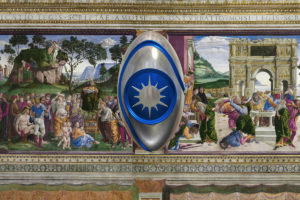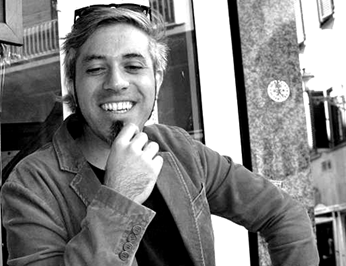Excluding the causes of force majeure, war or calamitous, in human memory there has been no blatant deprivation of local museum institutions since the times of the first modern wailings, when the taste prevailed over historical reason and the works were preserved for the enjoyment of a eager handful of lucky people. Deproved of a physical (and paying) public, the Museum has run copious critical issues, especially related to its identity. At the origin of many museum contexts, the decontextualization of the works and sometimes of the spaces was legitimized in the name of a universal opening, a “people’s fury” more inclined to conceive art artifacts as hunting conquests than as meditative occasions. The birth of sciences such as museology and museography has disciplined the sector, but also created standards that too often cause contemporary misunderstandings: teaching and the indispensability of the place.
These two points, absolutely necessary, implying direct experience with the work, have frozen the fruition in a materialistic event, an authentic paradox, and has developed very few constructive alternatives to the daily inflows of human flesh. Of course: art and museums live on the basis of people, but humanity cannot and must not live according to art.
Precisely because conceived by an artist, the solution devised by Luca Pozzi, regarding the vision of spaces bearing beauty and history, appears significant and effective in reflecting the infinite feasible possibilities. The project called The Dark Collection, an APP that can be downloaded free of charge from the author’s website, contains the individual poetics of the artist’s research, an aesthetic-media investigation imbued with quantum physics, but also opens up an original and relational scenario by marrying the coexistence of augmented reality with classical painting[1].
The Dark Collection stages ovoid figures built in 3D Graphics that hover near the paintings and altarpieces of the Brera ‘s picture gallery and the munificent frescoes of the Sistine Chapel: these places, quite random though arbitrary, already bearers of centuries-old historical-artistic connections , display two interesting suggestions related to the ocular presence of digital sculptures (appropriately named Third Eye Prophecy) that are worth mentioning, taking advantage of a charming metaphorical role of these gallery complexes to unravel the aforementioned didactic and logistical knots.
THE PROFANE EYE
[www.lucapozzi.com/project/the-dark-collection/]
On the Brera ‘s picture gallery it is pertinent to note the secularist sentiment that led to the demolition of the church of Santa Maria in Brera to gain space for the future collection of Italian Art, a more exegetic than critical approach, remembering how the collection was organized by two “technicians”, the artists Giuseppe Bossi and Andrea Appiani, infatuated with Lanzi’s theories: if the didactic necessity in the first decade of the 19th century can be legitimized only by visual accessibility, the current world requires a multisensory media conversation to qualify the value managed by the works of art .
Neither invasive nor affected, Luca Pozzi’s “Third Eye” nevertheless maintains the desire for an artistic intervention, in a “guerrilla style”, creating a visceral and trans-migratory relationship between the observer and the observed object, not only apparent but even physical, considering the smartphone as a real body appendix[2]. This educated transgression allows a structural reversal of the museum use, because it filters the vision to a shared subjectivity made active by a binary consciousness: teaching is no longer imposed but chosen in contemplation.
THE SACRED EYE
[www.lucapozzi.com/project/the-dark-collection-sistine-chapel/]
Speaking instead of the most recent proposal (issued on Easter 2020, while the first application was made available by Christmas 2019) prepared for the Sistine Chapel, the ocular signifier carries a much more complex load for the current function of place of worship. The political and theological reasons behind the construction of the papal oratory abound as much as the manifest allegorical references, weaving a visual and subliminal semantic connection[3].
In this case, Pozzi’s work aims precisely to rhizomatically amplify the interdisciplinary cases, correlating the theories relating to dark matter and cosmology with the philosophical, religious and artistic arguments inherent to the occupied space: the mystical vein of the room cloaks the suspended eye of an esoteric and metaphysical character[4], suitable for an iconography widely used also by the Catholic Church. No less pertinent is the transcendence evoked by the Sistine Chapel, which provides coded reading keys on the indispensability of the place, bringing the context to be the first actual public museum in history, because it is linked to performative elements (the liturgical ritual and the pilgrimage of visitors -faithful) who constantly “move” their physical permanence, exactly like the free activation of Dark Collection.
Once the extrasensory reflections have been removed, it is good to frame the analytical value of Dark Collection. The role and shape of the Third Eye Prophecy, actually taken from a tennis ball ovalized by speed with an explosive pupil in the center, are reminiscent, with due distinctions, of the Jeff Koons series called Gazin Ball, where the American artist positions (physically) a mirroring blue-electric sphere on faithful reproductions of well-known works of art of the past, from the Mona Lisa by Da Vinci, to the Madonna in Gloria by Perugino, up to the Breakfast on the grass of Manet. Both artistic works actually pose a dialectical question with traditional workers by preparing an object as a perceptual and empirical metric term, but there is a fundamental difference: while Koons realizes a deconstructive action, Pozzi is inclusive, implementing a space-based time “collaboration” between reality and its representation[5]. The multidisciplinary artist is not new to projects including classic scenarios (Wilson Tour Carracci, Supersymmetric Partner), however the evidence of Dark Collection stands out for the explicit and decisive relationship with the audience, the authentic “work” to be safeguarded, lightening generously and clearly a debate between visitor and local museum planning, which has long been opaque and darkened further in this period of forced removal: with the necessary precautions and filters, even an eclipse becomes an opportunity to be seen.
Luca Sposato
[1] There is an abundant bibliography on the relationship between aesthetics, technology and connected society; everyone should remember the contribution of Derrick de Kerckhove, author of Skin of Culture. See D. DE KERCKHOVE, The skin of culture: an investigation into the new electronic reality, Genoa, Costa & Nolan, 1996.
[2] This object-metaphorical correspondence evokes Georges Bataille’s Histoire de l’œil, to which an Italian edition accurately reports a comment by Barthes: “The Histoire de l’œil is truly the story of an object. How can an object have a story? It can pass from hand to hand (giving rise to insipid inventions like History of my pipe or Memories of an armchair), and it can also pass from image to image, its history then is the story of a migration, the cycle of reincarnations (in the proper sense) that it travels in detaching itself from the original being, following the inclination of a certain imagination that deforms it without abandoning it: this is the case in Bataille’s book.” cfr. R. BARTHES, The metaphor of the eye, in G. Bataille, History of the eye (1928), Milan, SE Editore, 2008, p. 155.
[3] It will suffice to cite Eugenio Battisti (1960) and Maurizio Calvesi (1997) to delve into the long and fascinating historical and iconographic event of the Sistine Chapel, still one of the most studied monuments in the world today due to questions not fully clarified.
[4] There are several confirmations on the comparison between the Jewish Kabbalah and the artistic structure of the Sistine, motivated by the desire to express an ideological superiority between the Jewish religion and Christianity. An example comes precisely from the aforementioned Battisti: the historian approached (and confirmation seems to come from an inscription on the building painted by Perugino in the Handing Over of the Keys) the dimensions of the Chapel supplied to them by biblical reading for the Temple of Solomon. In addition to the scientific team, the esoteric nature of the “inner eye” provided by enthusiasts of the genre is interesting for the topic. See R. STEINER, Theosophy. An introduction to the over-sensitive knowledge of the world and the destiny of man (1918), Milan, Carlo Aliprandi publisher, 1922.
[5] In particular, note the distinct character of the reflection on the sculptures of the two artists: the Koons ball “erodes” the light as a physical body and deprives it of the stable color of the paintings, Pozzi instead creates a sculpture that “technically” duplicates “the surfaces of the environment and concentrates them on the elliptical mass of the floating eye (body that, in fact, does not produce shadow), generating a sort of anti-reflection.
Info:
Luca Pozzi. The Dark Collection
curated by SWAN STATION
From December 25th – forever
Opening | December 24 at 24:00 when no one can be there
Timetables | Tuesday – Sunday / 8.30am – 7.15pm closed on Mondays.
Pinacoteca di Brera – Milano www.pinacotecabrera.org
Luca Pozzi. The Dark Collection – Sistine Chapel
curated by SWAN STATION
From April 12 – forever
Opening | April 12 at 00:00 when nobody can be there
Timetables | Monday – Saturday / 9.00 – 18.00 – closed on Sunday
Sistine Chapel – Città del Vaticano www.museivaticani.va
 Luca Pozzi, “The Dark Collection”, 2019. Luca Pozzi operates Third Eye Prophecy sculpture in 3D graphics between Alvise Vivarini (Blessing Redeemer) and the architectural boundaries of the Pinacoteca di Brera
Luca Pozzi, “The Dark Collection”, 2019. Luca Pozzi operates Third Eye Prophecy sculpture in 3D graphics between Alvise Vivarini (Blessing Redeemer) and the architectural boundaries of the Pinacoteca di Brera
 Luca Pozzi, “The Dark Collection”, 2019. Third Eye Prophecy sculpture in 3D graphics between Canaletto (View of the San Marco basin) and Bernardo Bellotto (View of the Gazzada), (Detail)
Luca Pozzi, “The Dark Collection”, 2019. Third Eye Prophecy sculpture in 3D graphics between Canaletto (View of the San Marco basin) and Bernardo Bellotto (View of the Gazzada), (Detail)
 Luca Pozzi, “The Dark Collection”, 2019. Third Eye Prophecy sculpture in 3D graphics between Paolo Veronese (Last Supper) and (The temptations of Christ)
Luca Pozzi, “The Dark Collection”, 2019. Third Eye Prophecy sculpture in 3D graphics between Paolo Veronese (Last Supper) and (The temptations of Christ)
 Luca Pozzi, “The Dark Collection – Sistine Chapel”, 2020. Third Eye Prophecy digital sculpture between Michelangelo (Last Judgment)
Luca Pozzi, “The Dark Collection – Sistine Chapel”, 2020. Third Eye Prophecy digital sculpture between Michelangelo (Last Judgment)
 Luca Pozzi, “The Dark Collection – Sistine Chapel”, 2020. Third Eye Prophecy digital sculpture between Perugino (Departure of Moses for Egypt) and Botticelli (Prove of Moses)
Luca Pozzi, “The Dark Collection – Sistine Chapel”, 2020. Third Eye Prophecy digital sculpture between Perugino (Departure of Moses for Egypt) and Botticelli (Prove of Moses)
 Luca Pozzi, “The Dark Collection – Sistine Chapel”, 2020. Third Eye Prophecy digital sculpture between Perugino (Handing over the Keys) and Rosselli (Last Supper)
Luca Pozzi, “The Dark Collection – Sistine Chapel”, 2020. Third Eye Prophecy digital sculpture between Perugino (Handing over the Keys) and Rosselli (Last Supper)

Luca Sposato was born in Tirano, Valtellina, in February 1986, he lives in Prato working in the Florentine metropolitan plain (Pistoia-Prato-Florence). Art historian, critic and curator of art and xylograph. He has curated exhibitions in private galleries, international fairs and public installations, both in Italy and abroad, including a review in historic buildings of Pistoia and the scenography of a musical show at the Textile Museum of Prato. He writes for various magazines both in print and online. His critical research starting from the art graphics, parallel practiced, focuses on the traced, physical and semiotic sign, expanding the study to the time synchronization between past and present, and cultivating curatorial practice as an artistic medium.






NO COMMENT